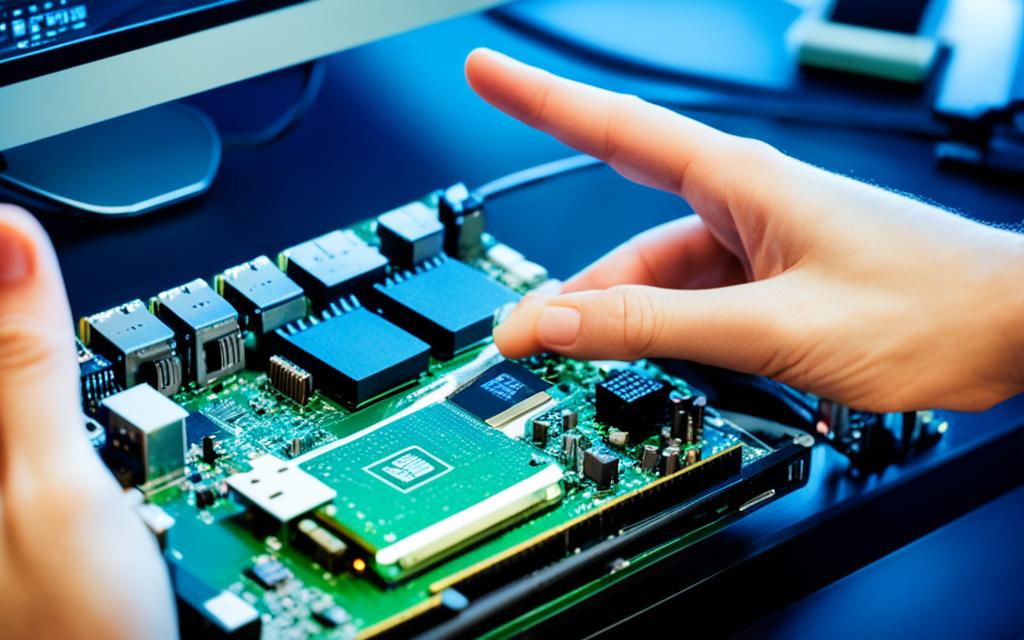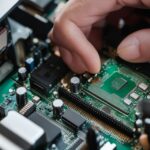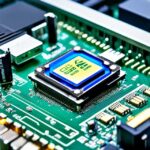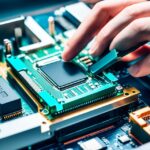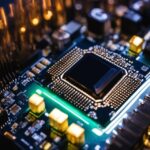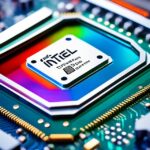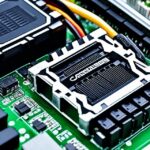Table of Contents
Updating BIOS without a CPU used to seem tough. Now, thanks to technology like BIOS Flashback, it’s doable. These advancements let us update the motherboard BIOS without a CPU. This makes the update process easier and vital for anyone into the latest tech. For example, the EVGA Z690 CLASSIFIED motherboard benefits greatly from this.
This change makes updating easier and shows why keeping the BIOS current matters. It’s key when you’re using top-notch parts. Like the Intel Core i9-12900KF processor and Seasonic VERTEX GX-1200 PSU. For those with high-end setups, learning to update the BIOS is crucial. It ensures their gadgets last longer and work better.
For steps on how to start your PC without a power button, check this handy guide.
Key Takeaways
- Updating BIOS can now be done without a CPU using features like BIOS Flashback.
- Users of motherboards from brands such as ASRock, Asus, Gigabyte, and MSI can greatly benefit from these advancements.
- Proper USB drive selection is crucial; USB 2.0 drives are recommended for a smoother BIOS update process.
- The average BIOS update file size ranges from 10 to 25 megabytes and can typically be completed within 2 to 10 minutes.
- Utilising the right methodology ensures that both bugs are fixed and new features are unlocked, enhancing overall system stability.
Why Updating Your Motherboard BIOS Is Important
Updating your motherboard BIOS is key to better performance and smooth working. It ensures your motherboard works well with new hardware. This is crucial as technology evolves quickly. An old BIOS might not support the newest CPUs or RAM. This could lead to issues that a simple update can fix.
Enhancing Compatibility with New Hardware
It’s vital your motherboard can handle new components. BIOS updates add support for new RAM and CPUs, boosting your system’s power3. Without updates, your motherboard may not work well with new parts. This could limit system upgrades and improvements.
Fixing Bugs and Improving System Stability
Old BIOS versions can have bugs, affecting your system’s reliability and speed. You might see random crashes or slow performance4. Updates fix these bugs and make your system more stable. They help your motherboard work better with other devices3.
Unlocking New Features Through Updates
BIOS updates fix issues and bring new features. They offer advanced settings to boost your system’s performance4. By updating often, you can enjoy these improvements. This can greatly enhance how your computer works.
| Update Type | Benefits |
|---|---|
| Compatibility | Enhanced support for new CPUs and RAM |
| Bug Fixes | Improved system stability and performance |
| New Features | Access to additional functionalities |
Updating your motherboard’s BIOS boosts your system’s life and performance. Each update can bring big improvements in compatibility, stability, and features4. Keep your system healthy with regular updates4.
Preparations for Updating Your BIOS
Getting ready for a BIOS update is crucial for a smooth experience. You’ll need to back up your data, figure out your current BIOS version, and prepare a USB flash drive. These steps reduce risks during the updating process.
Backing Up Your Data for Security
It’s essential to back up your data before a BIOS update. This step keeps your files safe from any unexpected issues5. Programs like EaseUS Todo Backup are great for creating system images and protecting your important files.
Identifying the Correct BIOS Version for Your Motherboard
Finding the right BIOS version for your motherboard is key. You can get the necessary information from the manufacturer’s official website6. Regular updates can boost your system’s performance and security5.
Choosing the Right USB Flash Drive
Selecting a suitable USB flash drive is important. Ensure it is formatted to FAT32 to move BIOS files successfully7. Be careful during the formatting process to prevent any update issues.
| Preparation Step | Description |
|---|---|
| Data Backup | Use backup software to create system images and save critical files before updating. |
| BIOS Version Identification | Consult the motherboard manufacturer’s website for the correct BIOS version. |
| USB Flash Drive Formatting | Format the USB drive to FAT32 to ensure compatibility with BIOS files. |
How to Update BIOS Without a CPU
If you need to update your BIOS but don’t have a CPU, the BIOS Flashback feature is here to help. This handy feature lets you skip having a CPU, RAM, or GPU which is great for building new computers. It’s especially useful for new systems needing the latest BIOS for CPUs like the AMD Ryzen 5000 Series on B550 and X570 motherboards. It’s important to know the BIOS flashing steps.
Utilising the BIOS Flashback Feature
Many motherboard brands such as ASRock, Asus, Gigabyte, and MSI offer a BIOS Flashback feature. First, download the BIOS file from the maker’s website to a FAT32 USB flash drive, which should be about 10 to 25 megabytes. Be sure to use a USB 2.0 drive, as some people have had trouble with USB 3.0 during updates2.
Step-by-Step Guide for the Update Process
Here’s how to flash your BIOS:
- Connect the power supply to the motherboard.
- Insert the prepared USB drive into the BIOS Flashback port.
- Press the BIOS Flashback button to start updating. This usually takes 2 to 10 minutes, shown by the LED light flashing2.
- Wait for the LED light to stop flashing, which means the update is done.
This BIOS updating method not only simplifies the process but also helps improve support for new RAM and system stability. Keep in mind, it’s only the latest motherboards that have this feature. Knowing the update process will save you time and hassle in the future4.
For a smoother and successful update, it’s a good idea to check out detailed guides on how to update your BIOS without a CPU. You can find some great tips here8.
The Do’s and Don’ts When Updating Your BIOS
Updating your BIOS might seem tough, but following some key steps makes it easier. First, check your motherboard model. This makes sure you pick the right BIOS version for your hardware. Also, prep your USB drive correctly. It must be formatted to FAT32 to avoid issues.
Recommendations for a Smooth Update
To keep your system safe, stick to these tips:
- Make sure your system is connected to a steady power source. This prevents power loss, which could harm the motherboard.
- Consult the motherboard manual to find the right USB port for BIOS flashing.
- Look into the BIOS Flashback feature. It allows updates without needing a CPU.
- Read update instructions carefully. Also, download the BIOS firmware from a trusted source only.
Pitfalls to Avoid During the Process
Here are some common mistakes to dodge:
- Do not cut power during the update. This could ruin the BIOS.
- Use only FAT32 for the USB. This ensures it works with the update.
- Updating without understanding fully can cause system issues or failure.
- Double-check if the new BIOS matches your hardware, especially the CPU.
Heeding this advice helps ensure BIOS update success. It minimises risks and keeps your system solid. Generally, BIOS updates aren’t needed unless you face problems or need an upgrade9. Knowing the right steps helps your motherboard work better and last longer.=”landscape”>
References say BIOS updates can take from a few minutes to over an hour. So, patience is crucial9.
For deeper knowledge, consider reading more such as understanding BIOS basics for a full view on the matter10.
Conclusion
Updating a BIOS without a CPU has changed motherboard maintenance. Features like BIOS Flashback make updates easier. Users can now easily keep their systems updated for better performance and compatibility.
Prioritising data backup and preparation before an update is key. It is essential to have the correct USB flash drive ready for BIOS Flashback. This helps avoid potential problems and ensures a smooth update process.
Knowing how to update the BIOS keeps computing experiences fresh. Staying updated improves system stability and prepares for future tech. For a step-by-step guide, check out this link11.
FAQ
Is it really possible to update BIOS without a CPU?
Yes, thanks to BIOS Flashback, updating the BIOS without a CPU is now possible. This feature is available on many modern motherboards. It simplifies maintenance and helps with compatibility upgrades.
What advantages does updating the motherboard BIOS provide?
A BIOS update boosts new hardware compatibility, solves bugs, and activates new features. It ensures your system works smoothly.
How do I prepare before attempting to update my BIOS?
Before updating, back up your data with trustworthy software. Make sure you have the right BIOS version for your motherboard. Also, you’ll need a USB flash drive formatted in FAT32 for the update.
What is the process for updating BIOS using the Flashback feature?
First, download the latest BIOS version from the manufacturer’s website. Then, get a FAT32-formatted USB drive ready. Connect your motherboard to power. Finally, press the flashback button after inserting the USB drive.
What best practices should I follow when updating my BIOS?
Make sure to confirm your motherboard model and pick the correct BIOS version. Have a steady power source during the update. Your USB drive must be FAT32 to prevent issues.
What common pitfalls should I avoid during a BIOS update?
Never cut the power while updating and don’t use an unsupported USB format. These mistakes can corrupt the BIOS and harm your system’s operation.
Source Links
- https://forums.evga.com/someone-please-help-me-bios-update-without-cpu-m3578652.aspx – someone please help me. (bios update without cpu)
- https://www.cgdirector.com/update-bios-without-cpu/ – How to update your BIOS without a CPU
- https://www.intel.com/content/www/us/en/gaming/resources/how-to-update-bios.html – How to Update BIOS – Intel
- https://www.easeus.com/backup-recovery/how-to-update-bios-without-cpu.html – In-depth Guide | How to Update BIOS Without CPU🔥
- https://www.ninjaone.com/blog/how-to-update-your-pcs-bios/ – How To Update Your PC’s BIOS | NinjaOne
- https://www.electronicshub.org/update-bios-without-cpu/ – How to Update BIOS Without CPU?
- https://www.partitionwizard.com/news/how-to-update-bios-without-cpu.html – How to Update BIOS Without CPU, OS, or USB
- https://glennsqlperformance.com/2020/11/09/flashing-your-bios-with-no-cpu-installed/ – Flashing Your BIOS with No CPU Installed – Glenn’s SQL Server Performance
- https://www.avg.com/en/signal/how-to-update-bios – How to Update BIOS on Your Windows PC
- https://community.spiceworks.com/t/updating-bios-without-no-monitor/934939 – updating BIOS without no monitor
- https://www.toolify.ai/hardware/update-bios-without-cpu-easy-bios-flashback-guide-top-motherboards-3155532 – Update BIOS Without CPU? Easy BIOS Flashback Guide + Top Motherboards!

